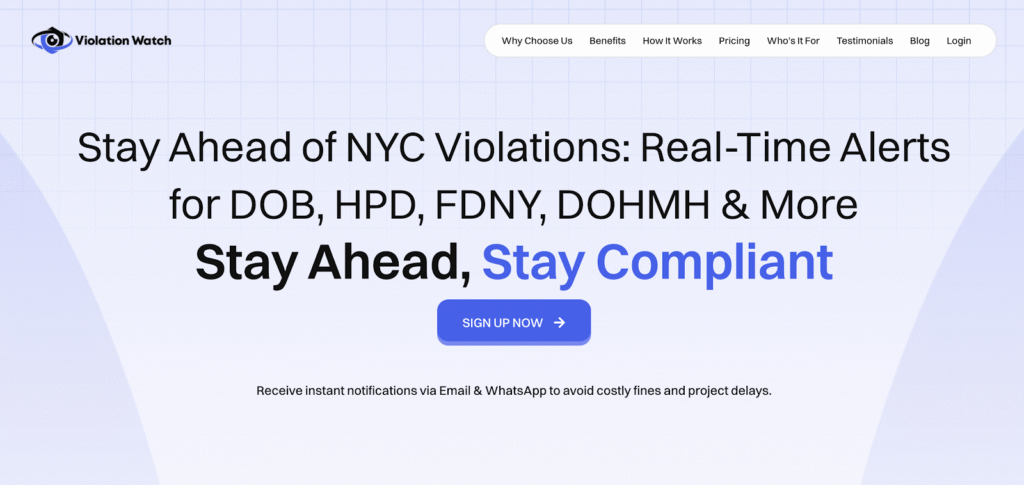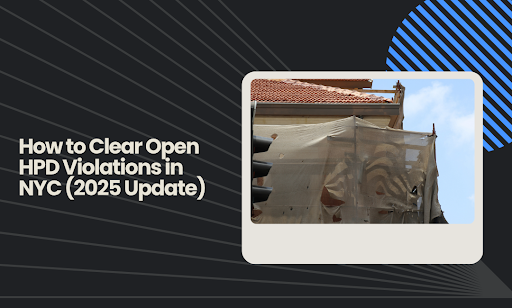Housing Preservation and Development (HPD) violations pile up faster than most people expect. One open violation can stall permits, derail financing, or block a property sale. Leave them unresolved, and the costs snowball. The 2025 update from HPD has changed the way violations appear, how they must be addressed, and the penalties for ignoring them. What worked last year might fail today.
Here you’ll get the key updates for 2025 — and clear, practical steps to remove open HPD violations before they escalate.
Here’s what we’ll cover:
- The 2025 HPD violation update: What changed, what stayed the same, and why it matters for compliance.
- How to clear open HPD violations: Proven steps, practical tools, and smarter ways to resolve them without losing time or money.
Expect clear, actionable tactics to resolve HPD old and new violations now and prevent future surprises under the 2025 rules.
The 2025 HPD Violation Update Explained

The Housing Preservation and Development (HPD) department made significant updates for 2025 that directly affect clearing HPD violations, especially for any property owner managing a multiple-dwelling portfolio. These updates change how violations are issued, tracked, and enforced, impacting inspection timelines, documentation standards, and penalties for late resolution.
Below is a clear breakdown for professionals handling compliance across New York City properties.
Key Changes in 2025
Before addressing violations, property teams need to understand the most impactful changes:
- Lead-Based Paint Testing Requirement – All rental units and common areas must undergo testing for physical condition hazards, including lead-based paint, by August 2025. Missing this date falls under the new certification periods set by HPD, triggering potential penalties.
- Stricter Code Enforcement – HPD enforcement teams now inspect more frequently for safety hazards like blocked exits, fire risks, or pest infestations, following different certification periods based on violation severity.
- Late Violation Protocols – Requests to correct violations after deadlines require formal dismissal submissions to the appropriate borough office, often with payment by money order or certified check if fees apply.
- Leadership Transition – The appointment of a new Acting Commissioner signals a stronger emphasis on compliance consistency across all three classes of HPD violations.
What Remains the Same
Despite the changes, several practices remain unchanged:
- Mandatory correction timelines for heat, hot water, and structural safety issues introduced in the past year remain in effect.
- HPD receives violation reports primarily through the Buildings Information System (BIS) and official HPD portals.
- Access to violation history and records through the HPD website continues without additional restrictions.
Why Clearing HPD Violations Updates Matter
Failure to comply under the certification period for each violation class leads to:
- Increased violation counts per property
- Higher cumulative fines
- Longer resolution timelines before compliance clearance
Staying aligned with the new certification periods ensures faster resolution, fewer penalties, and a stronger compliance record across portfolios.
How to Clear Open HPD Violations in New York – Step-by-Step Guide

Clearing open HPD violations requires precision, proper documentation, and strict adherence to deadlines. Skipping any step can prolong the process and lead to additional penalties. The following step-by-step guide helps property teams handle violations quickly and maintain full compliance.
Step 1 – Confirm the Violation Details
Before acting on any open violation, start with a full violation profile review in the Buildings Information System (BIS) or through the HPD portal. Focus on:
- Violation Classification: HPD categorizes violations as Class A (non-hazardous), Class B (hazardous), or Class C (immediately hazardous). Class C carries the highest urgency with strict correction timelines.
- Issue Date and Deadlines: Check original posting dates, compliance deadlines, and any existing hearing dates tied to the violation.
- Correction Requirements: Some violations, like lead-based paint or window guard infractions, have unique regulatory mandates beyond standard correction.
- Duplicate or Repeat Violations: Identify patterns across multiple properties or recurring issues that may require systemic corrections rather than one-off repairs.
This step creates the roadmap for the entire resolution process. Missing details here leads to incomplete dismissal packages and costly rejections.
Step 2 – Address the Underlying Condition
Corrective action must meet HPD’s technical compliance standards — a patchwork repair often fails reinspection and prolongs resolution. Depending on the violation type:
- Heat and Hot Water: Use licensed plumbers or boiler technicians to restore services, document system testing, and confirm temperature levels comply with the NYC Housing Maintenance Code.
- Lead-Based Paint Hazards: Engage EPA-certified contractors for inspection and remediation under Local Law 1 of 2004 protocols.
- Structural Safety Risks: For broken staircases, unstable ceilings, or façade hazards, retain licensed engineers or DOB-registered contractors to certify structural stability.
- Pest Control: Follow Integrated Pest Management (IPM) standards, documenting extermination dates, entry-point sealing, and tenant communication.
Compliance isn’t about fixing the symptom — it’s about correcting the root cause to prevent repeat violations.
Step 3 – Submit a Dismissal Request
Once the condition is corrected, the next step is a formal Dismissal Request submission to HPD. This isn’t a simple upload — HPD reviews these requests against strict criteria:
- Correct Violation Reference Number: Each violation has a unique identifier; errors here trigger processing delays.
- Completion Dates: All repairs must reflect completion before the dismissal submission date.
- Required Signatures: Some requests need owner or managing agent verification before acceptance.
- Supplementary Documents: Attach all supporting proof directly to the form rather than sending piecemeal files across multiple emails.
For time-sensitive Class C violations, prioritize immediate submission once repairs conclude to prevent accruing civil penalties.
Step 4 – Provide Proof of Correction
HPD evaluates proof packages carefully before dismissing any violation. Typical documentation includes:
- Before-and-After Photographs: High-resolution images time-stamped and labeled by unit, floor, or common area.
- Licensed Contractor Certifications: Affidavits from electricians, plumbers, or remediation contractors stating compliance with NYC codes.
- Inspection or Testing Reports: For hazards like asbestos, mold, or lead, attach lab results or clearance testing certificates.
- Repair Invoices and Work Orders: These validate the scope of work, materials used, and repair timelines.
Submit files in organized formats — large, unstructured submissions often delay HPD review cycles.
Step 5 – Send Documentation to the Right Office
Accuracy here prevents administrative limbo. Route all materials through the correct HPD Code Enforcement Borough Office or via the HPD online portal if the system supports electronic submission for that violation type.
Best practices include:
- Confirming receipt with a timestamped acknowledgment from HPD staff or portal submission records.
- Keeping copies of all forms, photos, and reports in a centralized digital repository for audits or future reference.
- Tracking assigned HPD review officers or case numbers for direct follow-ups.
Step 6 – Follow Up and Schedule Inspections
Many Class B and C violations require post-repair inspections before final dismissal. Key steps here:
- Schedule Inspections Promptly: Avoid backlog delays by booking the earliest available slot after repair completion.
- Prepare Units and Tenants: Tenants must allow inspector access; coordinate entry times to prevent failed inspection attempts.
- Maintain Inspection Logs: Document inspector names, dates, and outcomes for internal compliance records.
If an inspection fails, review the deficiency report carefully before resubmitting corrections to prevent repeat failures.
Other Practical Steps Worth Considering
Beyond the official HPD workflow, property managers can strengthen compliance efforts with:
- Portfolio-Wide Violation Audits – Quarterly reviews of all open violations help track violation status across every property address and prevent missed deadlines.
- Automated Deadline Alerts – Use digital calendars or property management software to avoid paying the dismissal request fee for late submissions and keep correction dates for class B violations and immediately hazardous conditions under control.
- Centralized Document Systems – Cloud-based platforms store repair photos, certify violations documents, and HPD department records securely, so owners can submit proof for closed corrected violations quickly.
- Pre-Inspection Preventive Maintenance – Routine internal inspections help identify hazards before HPD inspectors or the code enforcement office issue new reissued violations or escalate lead violations tied to lead-based paint violations and other different violation classes.
Manual tracking works for a few properties, but when building owners handle multiple units or a private dwelling portfolio, managing certification requirements, current property registration data, and reissuance notice deadlines becomes overwhelming.
That’s why many professionals rely on specialized compliance tools to certify correction, streamline lead paint remediation documentation, track certain violations, and meet strict timelines set by the New York City Department that govern housing quality. These tools make it easier to inspect properties, track violation classes, and keep every update in one place without juggling agency portals.
Moving from Manual Tracking to Smarter Compliance
Even with a disciplined process, clearing open violations across multiple properties becomes complex when the department records show multiple agencies issue violations for overlapping deadlines. Each step — from initial correction to submitting proof — often requires separate logins, manual document uploads, and coordination with the code enforcement office for inspections.
That’s where specialized compliance tools change the equation. A platform like ViolationWatch consolidates the entire workflow — from violation alerts and document storage to inspection scheduling — under one digital dashboard. Instead of juggling spreadsheets and agency portals, property professionals keep every violation detail, update, and proof record in one place.
The result? Faster dismissals, fewer missed deadlines, and better oversight across portfolios of any size.
Clear Violations Faster with the Right Tools

You’ve seen how HPD’s 2025 updates tighten deadlines, raise documentation standards, and increase the stakes for unresolved violations. We’ve broken down each step — from identifying the violation type to scheduling final inspections — so you have a clear framework to follow.
But here’s the reality: manual tracking works only until the volume of violations grows, deadlines overlap, and multiple agencies issue updates at the same time. That’s where modern compliance tools come in.
ViolationWatch brings all violation data, correction steps, and dismissal workflows into one organized system. Instead of chasing paperwork across different platforms, you see everything in a single, centralized dashboard — alerts, documents, deadlines, and inspection dates — all structured for faster resolution.For property teams handling multiple buildings, it’s not about convenience. It’s about preventing penalties, staying compliant, and protecting property value.

